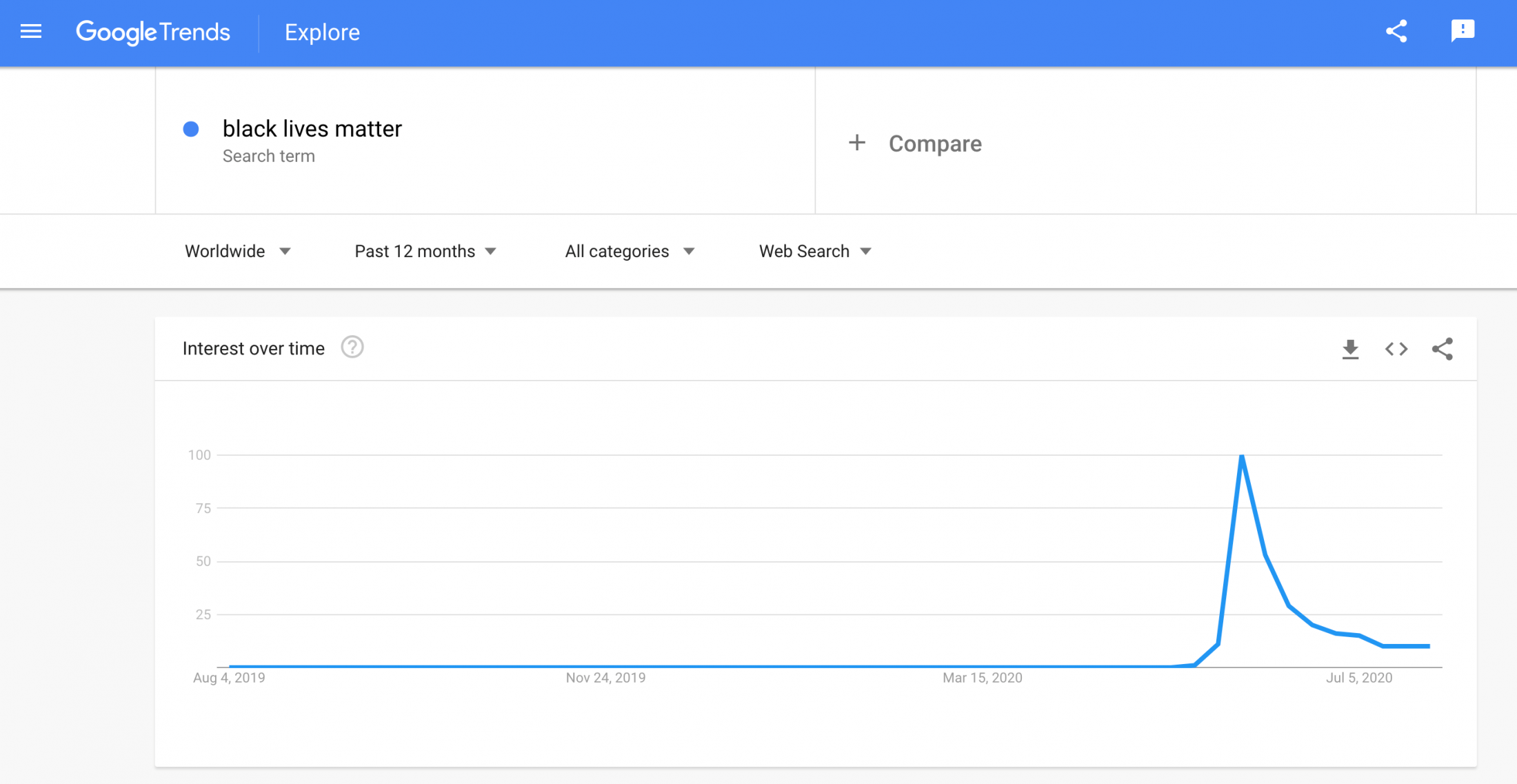
Google Trends graph showing spike in searches for 'Black Lives Matter' from May 2020. Data source: Google Trends
This article by Novuyo Moyo is part of the BLACK LENS series, commissioned for the SLG’s Convergence programme.
George Floyd’s murder has sparked an increased awareness and interest around racism and civil rights globally. No industry has been left untouched as we collectively reflect and begin to consider how structural racism impacts the different facets of everyday life.
Though discussions such as these won’t feel new to many people who look like me, the increased attention has allowed for more areas to be challenged and scrutinised more closely. One such question that reared its head in my personal sphere was that of whether charitable organisations such as public cultural institutions can or cannot align themselves with political movements.
The Charity Commission stipulates that charitable organisations must exist for a public benefit and that ‘an organisation will not be charitable if its purposes are political.’ It goes on to state that ‘however, political campaigning, or political activity, as defined in this guidance, must be undertaken by a charity only in the context of supporting the delivery of its charitable purposes.’
As the Black Lives Matter (BLM) movement gained momentum online, cultural institutions were amongst the organisations that reacted. Many posted a black square on their social pages alongside a #BlackLivesMatter hashtag to represent Blackout Tuesday and shared statements that were sometimes evasive as to what the underlying message was, leaving the level of their commitment and proposed anti-racism actions unclear. The neutrality displayed begins to shed light on the fuzzy line that cultural institutions have to tow in such moments of crisis. The question of whether charitable organisations should align themselves with political movements has become an even more divisive one in light of the tweets from BLM UK’s Twitter account in support of the Free Palestine Movement, which have received a mixed response and been labelled anti-Semitic.
BLM began as an instance of hashtag activism on social media, Twitter in particular, in 2013 after George Zimmerman was acquitted in the killing of Trayvon Martin, a black teenager in America. Three women, Patrice Cullors, Alicia Garza and Opal Tometi, who are all civil rights activists, artists, or writers, initiated a protest using the slogan Black Lives Matter to highlight how authoritarian violence and the deaths of black and brown bodies at the hands of the police affects not just men, but women in black communities as well.
Since then, the movement has evolved into a globally distributed organisation with official chapters in the US, UK and Canada, advocating against the racially motivated judicial and extra-judicial violence perpetrated against black people. Though its means of bringing about change may be apolitical, its subject matter is inherently political and therefore divides public opinion and most likely institutional strategies on whether it is a political movement.
In moments such as these, when all eyes are on institutions, pressure mounts and one needs to be seen to be doing something, these vague statements can seem like the only option. I should mention that there have been various attempts by cultural institutions in the past to address race and offer some sort of redress for white supremacy, which should be acknowledged for not coming about as a reactionary remedy to a crisis.
One that immediately comes to mind is Tate Modern’s 2017 exhibition Soul of a Nation: Art in the Age of Black Power. The exhibition sought to represent the work that was coming out of the decades that saw African Americans fighting for civil rights. As well intentioned as these examples may be, they do focus on the experience of black pain and suffering, doing away with the more nuanced and complex readings that other artists and exhibitions are afforded. There can be a tendency to constantly assume an Americentric perspective, ignoring our own experiences of blackness here in the UK and in other parts of the world. Writing specifically about a Kara Walker commission, Rianna Jade Parker’s informed piece for ArtNEWS touched on the latter point extensively. These are however still valid attempts at including the perspective and experience of a marginalised group.
Considering all the above, it is clear that most times the purposes of charitable cultural institutions, which exist in summary to provide unrestrictive access to the arts in the communities they are based, do have common ground with the aims of movements such as BLM and can do more to be explicit in stating and demonstrating this.
The way forward isn’t clear, won’t please everyone and will be long and arduous but it is worth it if cultural institutions are to be seen as living up to their proclamations surrounding commitments to diversity and inclusion. Beginning with employees at all levels that reflect the diversity of the communities they are active in, institutions would be well-advised to invest in the long-term development of diverse artistic production. Diverse not only in the faces behind the work, but also in subject matter. Black people, in the UK and elsewhere, have long-lived the reality of injustices that have only now come into mainstream focus and though the validation that comes from this recognition is bittersweet, it presents an opportunity for more to be done beyond this moment.
ABOUT
Novuyo Moyo is a social media editor at e-flux. She studied Art History at Goldsmiths, University of London. Novuyo is also a trustee of the South London Gallery.
BLACK LENS is an alliance of young Black writers, art historians and curators assembling around Black research, scholarship and cultural production.
Convergence is an ongoing series of critical conversations, screenings and written commissions, facilitated by the SLG and curated and hosted by invited guests.